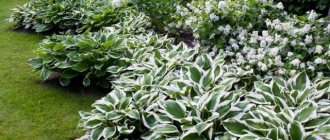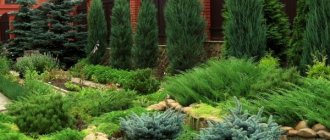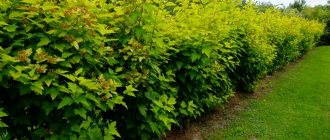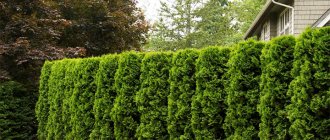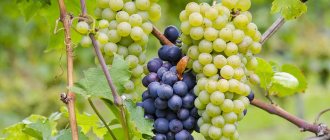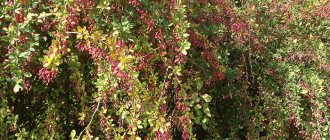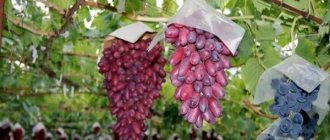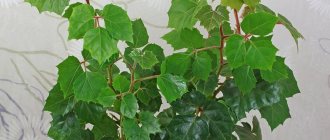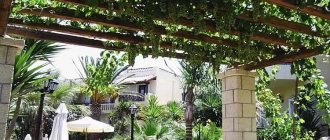Installing a hedge on a site is a troublesome task, but it allows you to get a beautiful and inexpensive fence, divide the garden into zones without cluttering up the common space. Depending on the choice of plants for a living fence, the entire appearance of the site will change.
A hedge dampens loud sounds well, prevents dust, and reduces air pollution. Green plants with different shapes and sizes of foliage have a positive effect on mood and relieve stress.
The plants that make up the living fence should be constantly looked after: watered and trimmed. If you don’t have the time or energy for this, it’s better to avoid this type of fence.
Maiden grapes as a fence
When selecting shrubs and vines for a fence, you should choose plants that are unpretentious, fast-growing and respond well to pruning. Grape hedges are very popular in our latitudes. Wild grapes on a fence exist perfectly in the Russian climate, do not require shelter for the winter, and can quickly grow green mass. Wild grapes form a spectacular thick head of large carved greenery on a fence, requiring only formative pruning.
The plant does not require lighting; it can be grown on the shady side of the building.
Interesting! The name “maiden” or “virgin” grapes was given for the peculiarity of setting fruit without fertilizing the flowers with male pollen.
The disadvantages of a vineyard as a fence include its low decorative value in winter. Fallen leaves expose bare lashes, which does not look aesthetically pleasing.
Wild grapes
A hedge of ivy, grapes, willow or hydrangea - how to choose a plant?
A hedge has a lot of advantages, which can be a significant argument for its appearance on the site. Regardless of which plant serves as a living fence, in any case it will be beautiful and impressive. Additional greenery in both willow and ivy hedges is always refreshing and adds color to the aesthetic appearance of the garden. And, if just aesthetics are not enough, then there are more compelling arguments:
- additional greenery protects from dust and purifies the air;
- a hedge made of plants does not need repair or painting. All this will be replaced by periodic haircuts and feeding;
- protects from wind;
- copes well with camouflaging unsightly barns and old fences;
- hides from prying eyes;
- creates additional shade and retains moisture;
- protects from street noise;
- attracts birds, hedgehogs and insects to the garden.
The versatility of living fencing cannot but please gardeners and simply lovers of nature and country holidays. But one of the important advantages is that there is a fairly wide selection of plants for hedges. This choice comes down not only to the tastes of the owner of the site, but also to the following points:
- purpose of a living fence;
- dimensions: planned height and required width;
- hedge density;
- climatic features of the region.
In order not to worry too much about whether a thuja or a palm tree will grow on the site, you can choose climbing plants. A hedge made from wild grapes or other climbing plants does not require much effort in planting and care, and the result will not be long in coming, as it quickly entwines the supports offered to it. Such plants take up little space on the site, but at the same time they can even entwine a house. To choose the right climbing plant, you need to consider several recommendations:
- in open areas and areas with strong winds, frost-resistant climbing plants should be planted;
- flowering vines will look good near the house or frequently visited places;
- Too expansive climbing plants should not be planted next to young plants;
- It is better to plant vines near a stone wall or fence that can cling to smooth stone or provide them with support in the form of a mesh or lattice.
Site preparation
Planting should begin in the fall, in September. This time is favorable for the development of a young plant, as the heat subsides.
Wild garlic - wild garlic
An area with any degree of illumination is suitable for a grape seedling. But you need to take into account that in the shade the plant develops slowly and in the fall the foliage will remain green. In a light area, the grapes grow quickly and in the fall they turn into bright yellow, purple and orange shades.
Important! The winegrower needs to know what a powerful and extensive root system wild grapes have. If you plant it too close to the wall of a building or a fence, over time, the roots will begin to destroy the foundation. The optimal distance from the bush to the wall is about 2.5 m. You should not place it near fruit trees and shrubs, as maiden grapes have a depressing effect on them.
The optimal support for grape vines is a metal mesh netting with large cells or a trellis with welded horizontal stripes for every 50 cm of column height. Plastic mesh, ropes and wooden supports are not suitable - they are not durable. The height of the fence is determined by the preferences of the gardener. The grape vines that have reached the top are planted horizontally to the sides or hung to the other side.
For planting, choose grape shoots that are no older than two years; it is better to take one-year-old plants. For every 1.5-2 m of fence length, take one seedling.
A trench is dug in the ground, the width of a spade bayonet, to a depth of 15-20 cm. Sand or crushed stone, gravel or expanded clay is poured onto the bottom. The thickness of the drainage layer is 3-4 cm. Above it, sprinkle with humus mixed with garden soil and begin planting.
Leaf humus
What are some design ideas?
Maiden grapes grown in landscape design are used to decorate various vertical walls; The photo will help you imagine what the results of the planned plan might be. This is a steeplejack who strives upward with enormous vitality, which neither snow, nor prolonged rains, nor premature frosts can stop.
Scheme for creating an arch for grapes
The liana takes root anywhere it comes into contact with a convenient surface and firmly grasps the support. It is enough for her to cling to the support once in order to continue to rise independently. It can crawl along a metal mesh, a water pipe, a wooden pole, or a metal rod bent into an arc.
Designers often use maiden grapes to create arches
Designers often take advantage of this dart frog's ability to completely braid a support, creating a lush canopy. They make beautiful arches, arranging them along the paths. Next, you can see how girlish grapes are used in landscape design in the presented photos of various arches.
Hedges can be created very easily using grapes
Hedges can be created very easily with the help of this fast-growing plant. Liana cuttings take root easily, and this allows you to obtain a sufficient amount of planting material in the second year to plant it along the line of the proposed fence. Designers suggest using metal posts and mesh as support, which can withstand the active growth of vines.
Maiden grapes will grow well along a stone wall
Maiden grapes will grow well along a stone wall, regardless of whether its plantings are located on the south or north side. Where there is little sun, it will grow just as actively, but its leaves will not turn red in the fall. At the end of the season they will become covered with yellow streaks and fall off.
Different types of maiden grapes in autumn landscape design are sometimes beautiful
On the south side, at the end of the summer season, the plant will delight with the burgundy-crimson color of its leaves, creating a stunning spectacle for lovers of wild colors. Different types of maiden grapes in autumn landscape design are sometimes beautiful, and the photos show all the beauty of this plant.
Breeders have developed a new variety of ornamental grapes, the leaves of which turn completely yellow in the fall. The wall, covered with vines with delicate leaves of deep rich yellow color, shimmers in the sun with all shades: from light to rich brown. This spectacle does not leave lovers of hedges indifferent.
Maiden grapes are not afraid of freezing
Wild grapes on the fence: how to plant
- The seedling is immersed in the soil exactly as it grew before. The root collar is not covered. If planting is carried out with a cutting, then it is placed obliquely, deepening it by 2 buds. It is important to press the soil tightly around the plant so that there are no voids left in the soil.
- Plants are watered abundantly, spending up to 10 liters of water per bush. To prevent water from spilling, sides of soil are created around the bushes.
- After watering, it is useful to mulch the surface of the earth with mown grass, sawdust, and peat. Mulch made from large tree bark and crushed stone looks decorative.
Girlish grapes on the balcony
Before the onset of cold weather, it remains to monitor the soil moisture, keeping it slightly moist.
Description and characteristics
Wild grapes are very rare in summer cottages. Gardeners consider it active in growth because the roots are difficult to get rid of. In addition, the fear that mice or rats will settle in the lush foliage of the root zone of the plant discourages many from planting vines in their plots. However, in addition to its aggressive qualities, the plant has many advantages. And with proper care, the unassuming vine will serve as a beautiful garden decoration.
Review of the best varieties of roses for the Moscow region || Post navigation || New entries || Interesting articles || Categories || Our group in classmates || Latest comments || Interesting video || Popular on the site || Best Potatoes || Glavnaya-dacha.ru 2015 || Our subscribers || Site statistics
Maiden grapes are a perennial vine that can withstand frosts down to -45 degrees without shelter, does not require abundant watering even in the most severe drought, and reproduces by all parts of the vegetative mass and by seeds. It reaches a height of 5 m to 30 m. In summer, the foliage has a white-green or rich emerald color, and with the onset of the first frost it changes to a cherry-red hue. By the beginning of September, the vine forms many clusters with small blue-purple berries, which waxwings and linnets love to feast on.
Grape shoots, when growing, use adventitious supporting roots that grow down from the stem and cling to the smallest protuberances. At the tips of milky sucker roots there are stomata through which the plant secretes the substance viscin. Thanks to it, the vine will attach to even the smoothest surface.
Wild grapes planted on a summer cottage will serve not only as a natural decoration on the site. The plant will protect buildings from getting wet - raindrops will flow down the leaves, leaving the walls dry. In addition, fences where the vine is planted will protect the owners from excessive noise, dust and “curious prying eyes.” Planted grapes near the walls of a multi-storey building will provide residents with protection from the scorching summer rays of the sun.
Care
Maiden grapes
The grapes do not require shelter for the winter; only young bushes can be covered with soil or peat to a height of 15 cm.
In hot summers, plantings require watering. A warm shower is beneficial for the foliage.
Fertilizing grapes is not necessary. In the spring, it is enough to mulch the soil under the plants with humus.
Twice a season, broken shoots are pruned and excess branches are removed. For better bushiness of young plants, pinch the top of the central shoot when it reaches a height of a meter.
Pinching grapes
How to tie up girlish grapes
The main shoots extending from the stem of the plant are spread in the form of a fan over the mesh and secured to it with ropes. Next, the grapes will begin to cling to the support themselves, gradually entwining it entirely. The gardener only has to control the direction, sending flexible branches in the right direction at the right time.
When the shoots outgrow the height of the fence, they are thrown to the other side or cut off. The plant needs to be trimmed several times a season. If this is not done, the grapes will quickly turn into a shapeless pile of tangled branches. The increased mass of greenery can break the supports and the entire structure will collapse to the ground.
